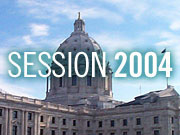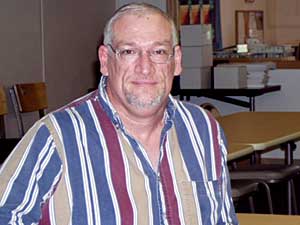Audio
Photos
Resources
Your Voice
| ||||||||||||||||||||||||||||||||||||||||||||||||
State will start charging recipients in AIDS drug program
May 27, 2004
The Minnesota Department of Human Services will require many low-income people who have AIDS or who are HIV positive to start paying more for their health care and drug coverage. DHS officials say the AIDS Drug Assistance Program is expected to run a significant deficit in the next year. They say the changes are needed to provide coverage to as many cases as possible. Critics say the changes are unreasonable since they come on the heels of significant budget cuts to HIV and other publicly subsidized health insurance programs.
St. Paul, Minn. — The AIDS Drug Assistance Program, known as ADAP, works like this -- the federal government provides Minnesota with about $3 million a year to pay for health insurance and drug coverage for low-income people living with HIV. The state also kicks in about $1 million a year for the program. Any single adult with HIV who earns less than $28,000 a year would be eligible.
The problem is that the program is growing at rates higher than what the state and federal governments are willing to cover. Shirley York with the Minnesota Department of Human Services says part of the growth is because people with HIV are living longer. She says the other problem is the rising cost of health care. York says those two factors will create a deficit of $2 million through next July.
 | |||
"The appropriation that we receive from the Legislature and the funding that we get from the federal government have not increased," York says. "And in order to reach out to as many people as possible, we felt that asking people to help contribute to the cost is a reasonable approach to take."
York says they want those enrolled in the program to offset a part of the deficit through a cost-sharing plan. On July 1, DHS will begin requiring 65 percent of those enrolled in ADAP to pay for part of their care. There are 1,040 people currently enrolled in the program.
The poorest of the poor won't be expected to pay a cent under the new rules. But those who earn between $9,000 and $28,000 a year will be expected to pay between 5 percent and 7 percent of their monthly income, and some drug co-pays, to remain in the program.
Bob Tracy with the Minnesota AIDS Project says longer life expectancy for people with AIDS/HIV cannot be blamed for the deficit.
 | |||
Tracy says cuts to MinnesotaCare and other state subsidized health insurance programs have forced many with HIV from those programs. Tracy says those people are now enrolling in ADAP as a last resort.
"We cut HIV prevention last year in this state. We cut health insurance last year in this state for low-income individuals, including people with HIV," Tracy says. "And now the administration is coming forward again, this time asking low-income people living with HIV to pony up first to fill a gap in a program. A gap that was created by this administration's doing."
Tracy says even with the new cost-sharing plan, ADAP will run a deficit.
Russ Lovaasen of Minneapolis is one of those who will be expected to pay more. He contracted HIV in the early 1980s. In 1994, Lovaasen stopped working and enrolled in ADAP. He says he didn't think he'd live to see the turn of the century, but his drug therapy worked so well that he's now living a relatively healthy life.
Lovaasen says he's now living on Social Security, which provides him with an income of $1,100 a month. He'll be expected to pay about $40 a month to remain in the ADAP. He says that's not a significant cost for most people. But it can be a lot for someone on a fixed income.
Lovaasen says the announcement has caused concern in the HIV community that budget cuts will harm an effective program.
"Not only are we on a slippery slope with this. We're sliding down. We slid down last year with the way money was done and allocated last year. And now we're further down that slope, and the reality is what we're looking at is we'll be in the ravine in the next two years," says Lovaasen.
Shirley York, with DHS, says the agency is discussing short-term fixes to make sure the program remains solvent over the next year. She says the last option would be to change eligibility rates for those who can access the program. York says it's also possible the funding problem could be fixed if the governor calls lawmakers back for a special legislative session.
|
News Headlines
|
Related Subjects
|


